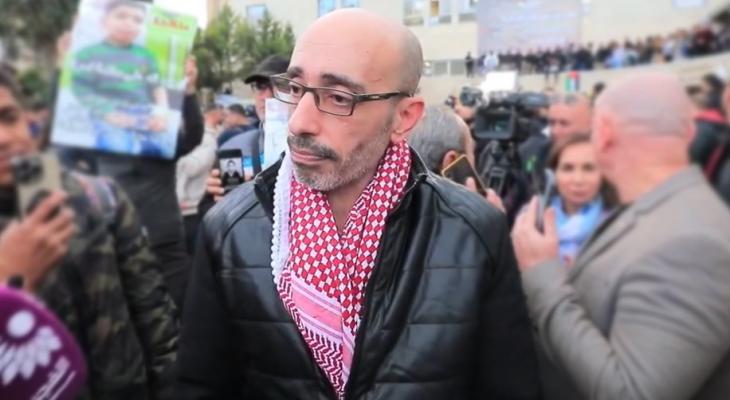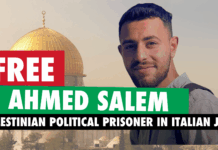
The following article, by Wael Jaghoub, liberated Palestinian prisoner freed in the Toufan al-Ahrar prisoner exchange, was originally published in Arabic in Al-Akhbar on Palestinian Prisoners’ Day, 17 April 2025.
Born on 23 May 1967, Wael Jaghoub was active in the Palestinian struggle from an early age. Amid the great popular Intifada of the Stones, he was arrested by the occupation in 1992 and sentenced to six years in occupation prisons. With the outbreak of the Al-Aqsa Intifada, he became one of the active leaders of the Popular Front for the Liberation of Palestine in Nablus. He was arrested on 1 May 2001 and sentenced to life imprisonment. During his years in prison, he was subjected to solitary confinement and denied family visits; he became a writer behind bars and published several books as well as many articles and studies, including this 2016 article. When he was released, he said: “I did not lose hope for 24 hours that the resistance would liberate me…and I continue to have hope that the resistance will liberate those left behind.”
The Palestinian Prisoners’ National Movement, First and Always!
Palestinian Prisoners’ Day: On the Experience of Struggle Inside the Prisons
Wael Jaghoub
It is inevitable that the experience of struggle of Palestinian prisoners inside the Zionist prisons—a natural extension of the overall Palestinian condition—must take into account the particularity of this arena, and accordingly, the importance of the concepts produced by this specific experience, which carry and represent this dimension.
The experience of struggle inside the prison is a daily and direct engagement with the colonial system in all of its components—political, security, judicial, and medical. At the same time, it is a confrontation and a defense of the moral and intellectual system that the imprisoned human being represents, which the colonial system works to control in a specific and stereotypical manner, stripped of its human and moral dimensions. The act of engagement emerges at this level when the prisoner confronts the jailer and defends these essential human and moral dimensions, making this a fierce confrontation at the level of consciousness.
It is worth noting that the concepts governing the struggle were produced by the specific experience inside the prisons, foremost among them hope—as both a moral value and a principle—relying equally on the dimension of will and the dimension of consciousness.
Collective consciousness is a vital and central link in the struggle; achieving the goals of the prisoners is impossible outside of its framework or isolated from it. One primary requirement for confrontation is an affiliated, organized and engaged leadership, alongside the practical model of work on the ground and the daily program—all of which are factors working together to translate vision and strategy into practice. The limited and defined reality inside the prison is governed by these concepts and the current reality of struggle requires them to be read and contemplated seriously.
The Experience of Struggle Between the Freedom Tunnel and October 7
Undoubtedly, the “Freedom Tunnel” represents one of the pivotal moments in the history of the prisoners’ movement and its long experience, with what it symbolizes and the repercussions and effects it has had on the broader national level, primarily in breaking down the walls of myth that had taken root in people’s minds—that we cannot overcome this enemy, nor can we defeat it or achieve victory over it. Victories of any size represent an important step in any people’s struggle: they instill hope, strengthen the will, and raise consciousness. This is exactly what this pivotal event represented, influencing also the context of the prisoners’ movement and its experience, becoming a significant and qualitative turning point. It shifted the prisoner once again from a focus on the daily, immediate, and personal to the broader strategic and national struggle, linking the prison with the entire homeland. It also correctly redefined the relationship between prisoner and jailer, removed all ambiguities, reinstated the effective presence of the prisoners’ movement, and restored the value of national unity as the true lever for every confrontation with its value, position, and impact.
It was a material translation of the collective dimension of the struggle. This is part of the Freedom Tunnel’s impact on the struggling reality of the prisoners’ movement. The prison administration considered the moment suitable to launch an assault on the prisoners’ movement, seeking to dismantle it and to thwart the anticipated impacts of the Freedom Tunnel on the prisoners’ movement internally as well as its engagement with the broader national liberation struggle. Therefore, multiple measures were taken: attempts to restrict daily living conditions, tighten oppression against prisoners, withdraw achievements, and apply repressive policies. This stemmed from a conviction that had become entrenched among the jailers—claiming that the prisoners’ movement was fragmented and could not resist or confront these policies, particularly given the Palestinian internal political division’s effects on the reality of the prisoners’ movement.
However, the prisoners’ movement possessed the necessary awareness to realize the importance of reconstituting the struggling dimension of the confrontation, rising above trivial or petty matters, and committing to a central mission: repelling the comprehensive aggression and the general offensive launched by the Zionist colonial security and political apparatus.
This must be considered the central task and the first step of struggle. This means setting aside all disputes and committing entirely to the mission, reflecting an advanced state of awareness that requires practical translation, embodied in the formation of an emergency leadership from across the political spectrum, forming an effective leading and guiding body for the entire prisoners’ movement, drafting a daily action plan for confrontation and resistance, and adopting the choice of resistance to repel the attack. This materialized through the formulation of a daily confrontation program—through daily protest steps—which reflected the unity of will and action and confounded the prison administration’s calculations. The preparation for launching an open hunger strike forced the prison administration to retreat from its measures and repressive steps.
The Stage Before October 7
For nearly two years, a crucial period in history and in the experience of the prisoners’ movement unfolded. Its main achievement was the establishment of a state of national unity and the adoption of the path of resistance. This opened the way for new ideas concerning the questions of imprisonment and its continuation, and the struggle for liberation and its possibilities. This led to the proposal of the “Freedom Strike,” aiming to seize prisoners’ freedom or embrace death, presenting a project and a plan in this regard, from which several important lessons and conclusions were drawn:
First: Confronting aggression can only be achieved through the formulation of a comprehensive united state, based on the foundation of resistance, defiance and confrontation. Unity must be founded on a clear, specific program within a clear framework and vision.
Second: Clarifying the goal of repelling aggression and focusing on what must be defined, without succumbing to the residue of disputes, divisions, and conflicting political stances, and instead formulating common ground.
Third: The condition of the leadership, providing the will to identify and comprehend the national situation and offering a model through its leadership of the confrontation.
Fourth: Collective participation by prisoners lies in formulating the unified path, supporting it, and reflecting the harmony between leadership and the grassroots bases.
Fifth: Repelling aggression is not achieved through absorbing it but through confronting and engaging it using all possible—and legitimate—tools at the moment of confrontation.
Sixth: Formulating consciousness and its changing concepts, including understanding the role and status of consciousness in the struggle.
These are some conclusions from an important phase preceding October 7, during a moment when the prisoners’ movement faced a fierce and widespread attack, during which the prisoners proved their worthiness of the challenge.
The Stage After October 7
This date marks another turning point in the form and level of the fierce assault on the prisoners’ movement. There was a transition from a stage of gradual cumulative targeting to the imposition of the so-called “Gilad Erdan Committee” decisions— named for Gilad Erdan, the Minister of Internal Security in 2017–2018, who formed the committee to study the measures to be taken against Palestinian prisoners in Zionist prisons.
At the time, the committee issued a report that included several measures, foremost among them dismantling the political presence of prisoners inside the prison, meaning ending the existence of organizations and collective representation of prisoners, targeting cultural and academic programs, and withdrawing all the achievements of the prisoners’ movement related to the conditions of daily life. These objectives, along with the plans to implement them, were already prepared by the prison administration. After October 7, they moved to the stage of comprehensive war against the prisoners’ movement, launching a savage assault based on a set of policies and procedures, summarized as follows:
First: The Policy of Deterrence
One of the components of the Israeli security doctrine, practiced against prisoners even before October 7, but its intensity drastically increased afterward. It became part of the framework of comprehensive war against the prisoners, manifested through the use of severe explosive violence against them—daily physical assaults inside the prisons, without distinction between a male or female prisoner, or between child or elder.
These violations led to thousands of injuries among prisoners, and even the loss of life for some, such as prisoner Thaer Abu Assab, who was martyred in the Negev prison as a result of beating. In addition, there were continuous raids day and night on prisoners’ rooms and sections, maintaining a constant state of fear and extreme tension, continuous transfers, and the confiscation of all belongings, including clothes, shoes, watches, electrical appliances, televisions, and radios, turning rooms into barren cells devoid of any minimum components of human life.
Additionally, the prison administration doubled or tripled the number of prisoners per room, as a form of abuse, harassment and intimidation.
This policy aimed to prevent any attempt at resistance by prisoners and to break their collective spirit by ending organizational existence, abolishing collective representation and ending the prisoners’ daily vital cultural and study programs. However, one of the main goals, as openly stated by prison officials, was revenge. This component is central to analyzing the behavior of this apparatus and understanding its effect on the prisoners.
Second: The Policy of Starvation
Starving prisoners by reducing food quantities by approximately 80% from normal levels was the first immediate step of this policy, followed by the confiscation of all foodstuffs from prisoners’ rooms and sections, forcing prisoners to rely solely on the scant daily meals provided. This resulted in severe weight loss among all prisoners, visible through the emaciation and physical weakness observed among released prisoners. A simple comparison between a prisoner’s image before October 7 and after release shows the severity of what prisoners are enduring, the horror of the prisoners’ lives and the cruelty of the prison authority’s starvation policy. The quantities of food provided to a section that housed ninety prisoners were drastically reduced, even though the section now held about 250 prisoners. Moreover, the food served was of poor quality, lacks salt, spices, or oil, and is often undercooked.
The aim of the starvation policy was to destroy the prisoner’s morale and body alike, limiting any capacity for resilience or resistance and trying to reduce prisoners’ thinking to mere survival instincts—what could be termed “hunger consciousness.” In this way, hunger governs the prisoner’s behavior and narrows his consciousness to a survival instinct. This is part of the prison administration’s vengeful assault on the prisoners.
Third: The Policy of Isolation
This policy was implemented through several measures, including the suspension of Red Cross visits to prisons, halting family visits, severely restricting lawyers’ visits, and confiscating televisions, radios, and any means of communication, isolating prisoners entirely from the outside world. The goal was to dismantle prisoners’ morale and push them to abandon options for resistance, making prison officers the sole source of information—most of which consisted of misinformation aimed at misleading and sowing confusion and tension among prisoners. This was one of the most dangerous policies employed.
Fourth: The Policy of Medical Killing
The previous policy of deliberate medical neglect was replaced by a policy of deliberate medical killing, through halting the majority of medicines provided to prisoners and stopping serious medical follow-ups that existed before October 7.
This led to the spread of skin diseases—most notably scabies—as well as respiratory illnesses, causing the martyrdom of a number of prisoners.
Available figures indicate that approximately 69 prisoners have been martyred so far due to these policies.
This policy is the most dangerous, aiming to inflict chronic diseases on prisoners, leading to death. The implementation of these practices constitutes an ongoing war crime inside the prisons, supported and endorsed by the political, judicial, and security levels in Israel, and continues to this day without interruption. Prisoners’ testimonies continue to highlight this terrifying reality within the prisons, threatening the prisoners’ lives.
What Is Urgently Needed Now?
In this context of ongoing aggressive war and genocide against our people everywhere—and foremost among those locations, inside the prisons themselves, where daily, ongoing and escalated torture has not stopped for a single day but has intensified—the urgent question “What is to be done?” reemerges. The answer remains generally confusing, regarding the forms of confrontation of this aggression, equally applied to the prisoners’ situation and to exposing it. There is disorganized, scattered effort without proper accumulation of achievements, in addition to the absence of planning, defining objectives, determining the goals of struggle and how to achieve these goals. Perhaps this stems largely from the absence of a general national strategy of confrontation, especially regarding the prisoners, based on the belief that they will eventually be freed. However, this does not negate the crimes that have occurred, nor the importance of struggle around this cause.
This responsibility places us before the urgent need to organize and plan the struggle around the prisoners’ cause, aiming at:
First: Attempting to repel the declared war and aggression against the prisoners, confronting it, and exerting pressure by all means.
Second: Highlighting the ongoing crimes, widely disseminating them, and presenting the Palestinian narrative in a broad and organized manner.
Third: Documenting the living memory of prisoners regarding this historical phase.
Fourth: Working to broaden the base of global solidarity, amplifying the voice of the prisoners, advocating for the justice of their cause, and building a serious Palestinian movement.
Achieving these goals requires broad, collective effort to achieve them, as well as a general will to strive for liberation, to achieve these and other goals. This requires expanding ties among institutions, movements, activists, and forces to build an effective international coalition as a mechanism and a bloc, based on clear objectives related to the prisoners, their freedom, the suffering they endure, and their struggle for their liberation and to repel the aggression against them.
Such a coalition necessitates a serious initiative to address several tasks within a action plan, the most prominent of which include:
First: Launching an escalating international campaign with the participation of institutions and forces at regional and international levels, organizing periodic public and mass events for the prisoners’ cause.
Second: Working to form a multi-party entity—Palestinian, regional, and international—whose primary task would be to document and register every prisoner’s experience after October 7 as a project of collective, struggle-based, authentic living memory, a real testimony to the crimes of the occupation, to be disseminated as widely as possible.
Third: Working to establish an entity, initiated by institutions, to provide support and care for released prisoners, especially those who suffered psychologically after their detention experiences post-October 7.
Fourth: Focusing on organizing media efforts on social networks, launching a “Before and After” photo campaign for each prisoner, and creating a traveling exhibition of photos both physically and electronically.
Fifth: Working within sectoral campaigns to highlight the cases of women prisoners, child prisoners, administrative detainees, the sick, and the elderly, portraying each prisoner as a story—not just a number.
There are many tasks and ideas that can contribute to repelling the aggression against prisoners, but they require thought, effort, will, and initiative.
It is not enough, on this day, to merely address the prisoners’ issue alone. Rather, we must consider Palestinian Prisoners’ Day a day for evaluating our role—what is required of us, what we can do, and what we need—so that the cause of the prisoners does not remain present only seasonally or incidentally.
Discover more from Samidoun: Palestinian Prisoner Solidarity Network
Subscribe to get the latest posts sent to your email.




